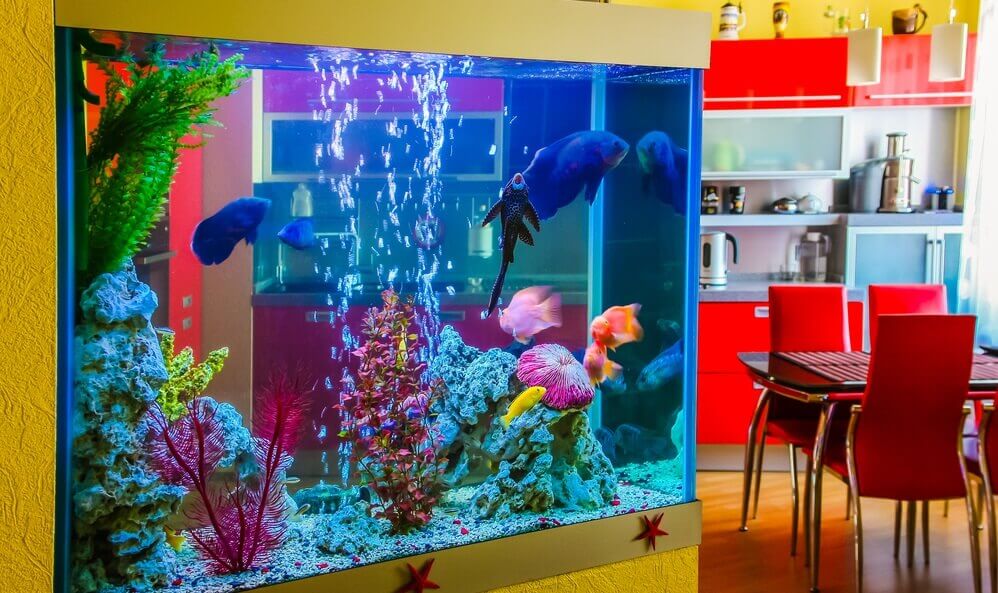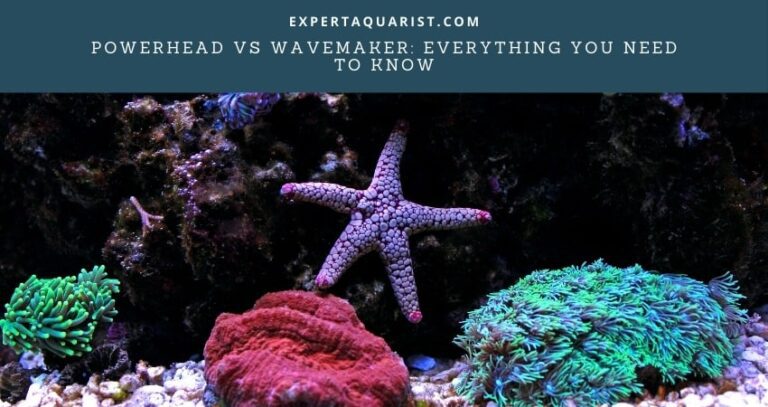The key to creating a modern aquarium is incorporating the various elements objectively and creatively. Each component has a functional aspect that you must think about. However, they also have aesthetic value that, if not well-thought-out, can result in an amateur-looking aquarium.
Below are 7 tips for incorporating the various components to create a modern aquarium.
Fish Types

There is a wide range of fish you can choose from to create a modern aquarium. They vary in ease of care and maintenance, temperaments, size, and their primary dwelling area. While some are best put together in schools or as a community, others are quite aggressive and are best kept on their own.
Some of the easiest fish to keep and care for include neon tetras, cherry barbs, guppies, mollies, betta fish, suckerfish, platys, and golf fish. If you are a beginner hobbyist, avoid black sharks, betta spendens, kissing gourami, and discus, as they require stringent water parameters.
Another factor to consider when shopping for pet fish is their decorative aspects. You can use the fish to create a color spectrum. There is a wide range of brightly colored fish. Typically, saltwater fish are more colorful than freshwater. You can also incorporate reefs in saltwater aquariums to boost the aesthetics. That said, there are also many varieties of colorful freshwater fish to choose from.
Decide whether you want an overtly colorful aquarium or a minimalistic one. Also, establish if you prefer a given fish color with your décor and ambiance.
Choose fish according to their predominant dwelling areas. For instance, you can put compatible low-dwellers with medium-level or top-level dwellers to fill up the empty spaces in the fish tank. However, avoid overcrowding the fish and offer ample space for them to swim, feed, and hide.
Lighting

Lighting is crucial in enabling fish, coral reefs, and aquatic plants to thrive and for creating a color spectrum for an enhanced aesthetic of your aquarium. Typically, a fish-only freshwater tank requires low to medium lighting. However, saltwater aquariums, particularly those that have coral reefs, require to be well-lit.
In most cases, a standard LED light is sufficient. However, you can go for a lighting unit with various color modes and intensities to amplify the decorations and color hues of the fish and plants in the aquarium.
Go for the full RGB spectrum for a freshwater aquarium. It brings out the colors more vividly and also prevents algae growth. It is also suitable for growing plants that require moderate to low lighting conditions.
8000K white light creates a warm ambiance and enhances the colors red, yellow, green, orange, and gold in fish. It mimics shallow water conditions and is suitable for a planted fish tank. On the other hand, 10,000k white light enhances colors blue, red, and shiny fish such as cardinal and neon tetras, African cichlids, and American cichlids. You can also use magenta or deep blue LED lights.
Substrate

You can use numerous substrates for your fish tank aquascape, including clay, gravel, sand, akadama, crushed corals, laterite, peat, and aqua soil. They vary in size, texture, and color. The right type depends on the type of fish, whether your fish tank is planted, and preferred aesthetics.
Gravel and sand are the most commonly used. Peat helps to soften the water and lower pH while providing nutrients to the plants, while crushed coral raises the pH and hardens water. Clay serves as a biological water filter and helps extract ammonia from the water.
The substrate should offer support, nourishment, and adequate aeration to aquatic plants while promoting balance in the various water parameters. For instance, a substrate with large-sized particles hides leftover foods leading to an increase in ammonia and nitrite levels. On the other hand, if it is too fine-grained, it inhibits aeration leading to the growth of anaerobic bacteria.
In terms of aesthetics, a dark substrate causes light-colored fish to stand out. Conversely, a dark-colored substrate makes a small tank look enlarged, especially in a nano aquascape.
To create a natural-looking ambiance, place large-sized substrates near focal points, such as wood and rocks and smaller-grained gravel near the edges. Lay the substrate shallowly towards the front of the fish tank and higher towards the back to create an illusion of depth.
Substrate layout that is thick towards the front looks amateurish. You can also slope it to incorporate molds and dips to create an illusion of hills and valleys.
While brightly-colored substrate makes an aquarium look colorful and bright, it is not recommended as it has dye, which can harm the fish and plants.
Plants

Whenever possible, use a variety of plants in your aquarium. For instance, mixing up a few marsilea plants with carpet-like dwarf hairgrass is a great choice. It makes the aquascape look natural and eye-catching.
If you incorporate carpeting plants, ensure it extends only a few inches to the back. The remaining uncovered substrate creates an illusion of depth and expansiveness.
You can also incorporate stem plants alongside carpet plants. Unlike what most articles recommend, incorporate stem plants heavily, especially if you have a large aquarium. It wades off algae and makes your fish tank look fuller. Trim the plants frequently to prevent them from becoming too bushy.
Ideally, you should place small plants at the front and big plants at the back. It creates a layered view of the tank and prevents taller plants from covering and hiding shorter plants. You can also use the plants strategically to hide aquarium equipment such as tubing, filters, and heaters for a natural-looking aquascape.
Placement

There are numerous placement options for an aquarium, depending on its size and your available space. Smaller aquariums are often placed strategically on countertops. Larger aquariums can be built-in into walls, cabinets, staircases, kitchen islands, room dividers, fireplace surround, etc.
Some tips for choosing the right placement for your aquarium include:
- Avoid areas prone to extreme cold or heat to prevent water temperature fluctuations
- Place it near electrical outlets. Most aquariums require three electrical sockets to power components such as a heater, filter, pump, and lighting. Mount the aquarium in such a way as to prevent splashes on the electrical sockets
- Place it near a freshwater supply and water disposal area. It makes water change and cleaning the tank easy
- Do not place small aquariums near high-traffic areas. They can be easily knocked over, or the fish may be scared by people passing by
- Place it in an area that offers you a good view
Decorations
For a professional-looking aquarium, avoid cluttering the fish tank with cheap decorations. Be selective about the type of decorations you incorporate. Since the goal of setting up an aquarium is to replicate the natural underwater environment, avoid decorations that would not be naturally found in the aquatic landscape.
Some of the most functional yet aesthetically pleasing decorations include driftwood, rock, and corals.
Determine a single focal point for the fish tank and use the various decorations to highlight it. For instance, you can use a large piece of rock or driftwood to create the focal point. Then use other smaller decorations, such as smaller rocks and plants, to complement it. The focal item should be placed on one side instead of the center.
Layout
Determine a layout for your fish tank. A layout ensures that you do not place items haphazardly in the tank.
There are three common layouts for a professionally-designed aquarium: mountain style, island setup, and concave setup. Each setup has specific design principles.
For instance, a mountain–style layout requires that you place large and tall rocks on one side of the tank to form a peak. The substrate also slopes with the shallowest area near the front of the fish tank. You can add plants between smaller rocks and leave some parts of the aquarium open.
For an island set up, lay out the plants and substrate sloping from one side of the fish tank to the other to create the illusion of a sloping ocean shoreline. For a concave setup, place taller plants on the outer edge and shorter plants towards the center. A concave layout provides an open view of the fish. Look up various aquarium layouts online for inspiration.
Conclusion
With a few tricks, your aquarium can have a well-executed aquascape. Therefore, before you buy the various components, think about the ambiance and layout you are going for and the functionality of each component.
The first crucial decision is the type of fish, as it will determine the appropriate size of the tank and water parameters. It will also guide the plant type, substrate, decorations, and lighting to incorporate.






